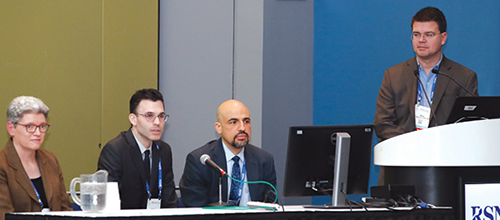Technology Can Aid Healthcare Team Communication
An evolving arsenal of tools help in a variety of ways, including with patients
With continuous advancements in technology, radiologists have access to more tools than ever to combat breakdowns in communication with referring physicians and to ultimately play a greater role in improved patient care.
During RSNA 2017, Max Wintermark, MD, professor of radiology and chief of neuroradiology at Stanford University, moderated a panel of presenters focused on identifying costly communication gaps between radiologists and referring physicians while broadening awareness of some creative and strategic ways radiologists are leveraging technology to be more active in patient care after imaging.
Often overwhelmed with heavy workloads, radiologists may be hesitant to assume additional responsibilities related to conveying test results and ensuring proper follow-up with patients. Yet those activities can play an important role in not only carefully interpreting images and making recommendations but also acting as a safe, patient-centered back-up system and ensuring that actionable results are not overlooked.
Virtual Connections
Among the creative methods highlighted were a virtual consult application and virtual rounds. Each follow the traditional model of a group of specialists meeting to review patient films and discuss the course of care. However, through these virtual meetings, the teams can use available technologies to overcome the challenge of gathering specialists in one place. Instead, they may teleconference from separate locations and accomplish the same care goals.
The virtual consult application is particularly important in the emergency department because it cuts through the problem of accessing help and can deliver an immediate benefit to the patient. “This is also especially useful where experts may not be in the area where patients live. Their access to care is not limited by geographic boundaries,” Dr. Wintermark said.
Bridging the Data Divide
As a result of advancements in artificial intelligence, future radiologists will move toward a more data-driven environment with more clinically useful work and less mechanical work related to interpreting and reporting. Data-driven image acquisition, data extraction, data-assisted interpretation and data-oriented reporting are all part of the future of radiology.
Using a wealth of data from a wide variety of sources, radiologists can turn reporting into the optimal tool for advancing patient care. The challenge is to bridge the divide between imaging data and clinical data, presenters said. The answer may be to employ technology to gather rich data from all sources and provide layered reporting that includes details more useful to referring physicians and more understandable to patients, they said.
Maintaining a Personal Connection
Although technology can increase communication, it can also be a barrier between radiologists and their clinical colleagues. It has the potential to lead to de-personalization during care. Dr. Wintermark said the key to incorporating technology effectively is striking the right balance, providing the patient access to expertise while retaining a familiar connection with a trusted provider.
“Though the patients do not generally see radiologists, radiologists see the patients, and the patients are the center of our concerns — prioritized above all else,” Dr. Wintermark said. “IT tools are used to better serve the patient behind the film.”

Web Extras
- View a video of Dr. Wintermark discussing interacting effectively with referring physicians in the digital age at RSNA.org/News.